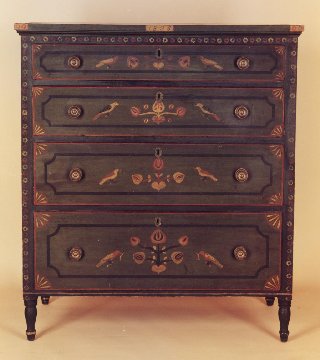A Manantongo Treasure Chest
I rarely get a chance to visit New York City during mid January, when, in approximately a two-week period, the most exciting antique events of the year take place. 1998 was different. Dorothy dreamed of Oz. Fishermen's fantasies are made up of giant lake trout. Baseball fans want to see Mark McGuire wallop a homer. My goal was to lay eyes on one of the world's greatest, fresh-to-the-market, newly discovered antiques. Even if could not afford it, I wanted to experience it.
At Christie's auction house, I inspected the hairy paw foot, piecrust top, carved mahogany Philadelphia Chippendale tea table that, according to word on the street, a Litchfield, CT area picker scooped up for $1,400 at a Hartford, CT area auction. The table sold for $600,000. At Sotheby's Important Americana Auction, I was drawn to the labeled Seymour card table that school teacher Claire Beckman bargained away at a garage sale some 30 years ago for $25. First identified on the Antique Roadshow, the table was hammered out for $541,000. "Way to go Claire!" I said from my auction seat.
Antiques had been culled in to the Big Apple from all over the world. During Antique Week I saw 18th century highboys and lowboys, and Baltimore album quilts, and Tiffany Lamps, and an original painting by Frederic Remmington, and another card table-this one had ball and claw feet-that sold for what I understand was four million dollars! Still, I had not found my own personal favorite kind of object. Then, I walked into Wayne Pratt Inc.'s booth at the 44th annual Winter Antique Show at the Seventh Regiment Armory at Park and 67th.
 My mouth dropped. The mint condition pine and poplar Sheraton (1800-1840) period chest was painted with a green base, outlined in red and yellow with painted fan spandrels in the corners. It was embellished with birds, stylized hearts and tulips, four point compass stars, and red and yellow red rosettes were painted up and down and all across the case stiles. As Pratt furniture experts Johanna McBrien and Mary Beth Keene pointed out to me, it was typical of line of elaborately painted furniture made by German immigrants who populated a number of river valleys centered by Schwaben Creek joining Northumberland and Schuykill Counties in the blue Mountains of Pennsylvanian. The "Mahantongo Valley"chest was even dated,"1835." It was, perhaps, the finest piece of painted furniture I had ever seen.I asked the price. High as it was it seemed a bargain. Not a bargain within my, or most men's means, however. Well, at least I could pull out a drawer. Scholars believe that the bold free hand and stencil paint decoration on Mahantongo furniture is based on Germanic Fractur and Taufschein birth and marriage records. The somewhat isolated Pennsylvania Germans who fashioned it employed decorative elements distinctive to their own culture. Twelve or more artists may have worked on the 100 or so surviving chests, blanket chests, cupboards, and small painted woodenware that have been found extant. The masterpiece I inspected sold within an hour. Wayne Pratt had purchased the chest in a private residence and he had helped to make my week by showing it for the first time in New York. The thing is, he only lives a mile up the road from me. Remember Toto, "There's no place like home. There's no place like home."
My mouth dropped. The mint condition pine and poplar Sheraton (1800-1840) period chest was painted with a green base, outlined in red and yellow with painted fan spandrels in the corners. It was embellished with birds, stylized hearts and tulips, four point compass stars, and red and yellow red rosettes were painted up and down and all across the case stiles. As Pratt furniture experts Johanna McBrien and Mary Beth Keene pointed out to me, it was typical of line of elaborately painted furniture made by German immigrants who populated a number of river valleys centered by Schwaben Creek joining Northumberland and Schuykill Counties in the blue Mountains of Pennsylvanian. The "Mahantongo Valley"chest was even dated,"1835." It was, perhaps, the finest piece of painted furniture I had ever seen.I asked the price. High as it was it seemed a bargain. Not a bargain within my, or most men's means, however. Well, at least I could pull out a drawer. Scholars believe that the bold free hand and stencil paint decoration on Mahantongo furniture is based on Germanic Fractur and Taufschein birth and marriage records. The somewhat isolated Pennsylvania Germans who fashioned it employed decorative elements distinctive to their own culture. Twelve or more artists may have worked on the 100 or so surviving chests, blanket chests, cupboards, and small painted woodenware that have been found extant. The masterpiece I inspected sold within an hour. Wayne Pratt had purchased the chest in a private residence and he had helped to make my week by showing it for the first time in New York. The thing is, he only lives a mile up the road from me. Remember Toto, "There's no place like home. There's no place like home."

